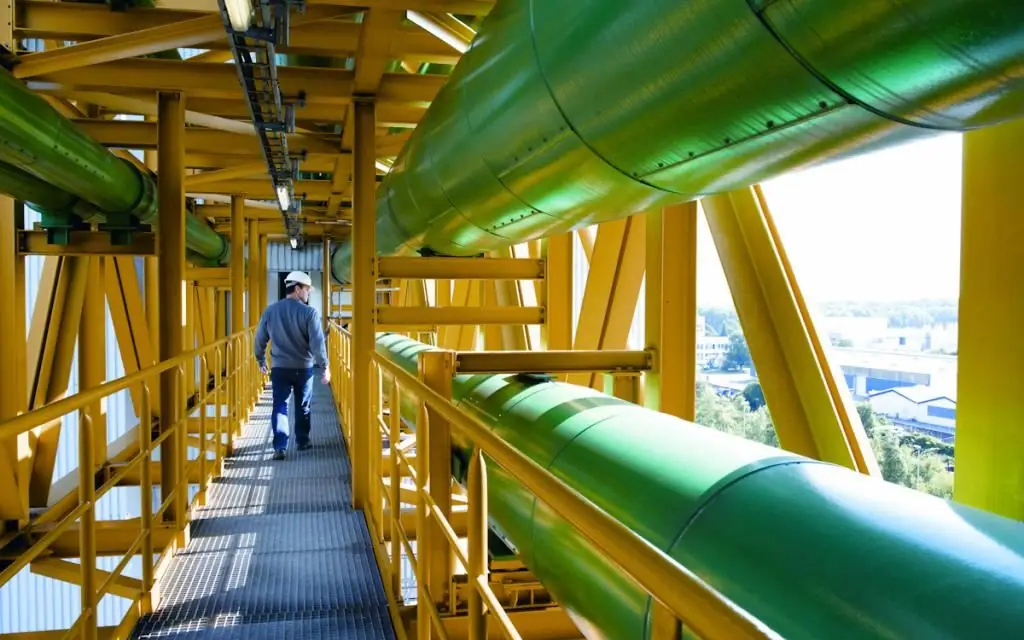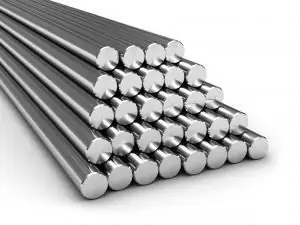2025 Author: Howard Calhoun | [email protected]. Last modified: 2025-06-01 07:12:56
In the hydraulic calculation of heat networks, the total flow rate of the main hot water for heating, air conditioning, ventilation and hot water is set. On the basis of such a calculation, the necessary parameters of pumping equipment, heat exchangers and pipe diameters of the main network are determined.
A little about theory and problems

The main task of the hydraulic calculation of heat networks is the selection of the geometric parameters of the pipe and the standard sizes of the control elements in order to provide:
- qualitative-quantitative distribution of the coolant to individual heating devices;
- thermal-hydraulic reliability and economic feasibility of a closed thermal system;
- optimization of investment and operating costs of the heat supply organization.
The hydraulic calculation of heat networks creates the preconditions for heating and hot water devices to reach the required power at a given temperature difference. For example, with a T-chart of 150-70 oS, it will be equal to 80 oS. This is achieved by creating the required water pressure or coolant pressure at each heating point.
Such a prerequisite for the operation of the thermal system is implemented by competently setting up the network equipment in accordance with the design conditions, installing equipment based on the results of the hydraulic calculation of thermal networks.
Stages of network hydraulics:
- Pre-launch calculation.
- Operational regulation.
Initial network hydraulics in progress:
- through calculations;
- measuring method.
In the Russian Federation, the calculation method is predominant, it determines all the parameters of the elements of the heat supply system in a single settlement area (house, quarter, city). Without this, the network will be deregulated, and the coolant will not be supplied to the upper floors of multi-storey buildings. That is why the beginning of the construction of any heat supply facility, even the smallest, begins with a hydraulic calculation of heat networks.
Drafting a diagram of heat networks
Before hydraulic calculations, a preliminary scheme of the main line is performed indicating the length L in meters and D of engineering conduits in mm and the estimated volumes of network water for the design sections of the scheme. Head losses in heat supply systems are divided into linear, arising in connection withrubbing of media against pipe walls, and losses in sections caused by local structural resistance due to the presence of tees, bends, compensators, bends and other devices.
Calculation example for hydraulic calculation of heat networks:
- First, an enlarged calculation is performed in order to determine the maximum network performance that can fully provide residents with heating services.
- Upon completion, the qualitative and quantitative indicators of the main and intra-quarter networks are established, including the final pressure and temperature of the carrier at the inlet nodes of heat consumers, taking into account heat losses.
- Perform a test hydraulic calculation of the heating system for heating and hot water.
- They establish the actual costs in the sections of the scheme and at the inputs to residential facilities, the amount of heat received by subscribers when calculating the temperature of the coolant in the supply water pipeline of heating systems and the available pressure in the outlet manifold, the rationale for hydrothermal regimes, the predicted temperature inside residential premises.
- Determine the required outlet heat supply temperature.
- Set the maximum size T of heated water at the outlet of the boiler room or other heat source, obtained on the basis of the hydraulic calculation of the heat network. It must ensure indoor hygiene standards.
Applying the normative method
The hydraulics of networks is performed on the basis of tables of maximum hourly heat loads and a heat supply scheme for a city or district indicating sources, location of main,intra-quarter and intra-house engineering systems, with the designation of the boundaries of the balance sheet ownership of the owners of networks. Hydraulic calculation of pipelines of heating networks of each section up to the above scheme is carried out separately.
This calculation method is used not only for heating networks, but also for all pipelines transporting liquid media, including gas condensate and other chemical liquid media. For pipeline heat supply systems, changes must be made to take into account the kinematic viscosity and carrier density. This is due to the fact that these characteristics affect the specific head loss in pipes, and the flow velocity is related to the density of the transit medium.
Parameters of the hydraulic calculation of the water heating network
Heat consumption Q and the amount of coolant G for the plots are indicated in the table of maximum indicators of hourly heat consumption for the winter and summer seasons separately and corresponds to the sum of heat consumption for the quarters included in the scheme.
An example of a hydraulic calculation of a heat network is presented below.

Since calculations depend on many indicators, they are performed using numerous tables, diagrams, graphs, nomograms, the final value of heat consumption Q for in-house heating systems is obtained by interpolation.
The amount of fluid circulating in the heating network m3/hour, when calculating the hydraulic mode of the heating network, is determined by the formula:
G=(D2 /4) x V, Where:
- G - carrier consumption, m3/hour;
- D - pipeline diameter, mm;
- V - flow velocity, m/s.
Linear pressure drops in the hydraulic calculation of heat networks are taken from special tables. During the installation of heating systems, tens and hundreds of auxiliary elements are installed in them: valves, fittings, air vents, bends and others, creating resistance to the transit medium.
The reasons for the pressure drop in pipelines can also include the internal state of the pipe materials and the presence of s alt deposits on them. The coefficient values used in technical calculations are given in the tables.
Standard methodology and process steps
According to the method of hydraulic calculation of heat networks, it is carried out in two stages:
- Construction of a heating network scheme, on which sections are numbered, first in the area of \u200b\u200bthe central highway - a longer and more voluminous network line in terms of load from the connection point to a more remote consumption facility.
- Calculation of head loss for each pipe section, scheme. It is carried out using tables and nomograms, which are indicated by the requirements of state norms and standards.
First, the calculations for the main highway are carried out according to the costs set according to the scheme. At the same time, reference data of specific pressure losses in networks are used.
Further, having calculated the diameters of the pipes, they calculate:
- Number of compensators according to the scheme.
- Resistances on actually installed elementsheating networks.
Head loss is calculated by formulas and nomograms. Then, having this data throughout the network, the hydromechanical regime of individual sections is calculated from the place of flow splitting up to the end user.
Calculations are linked to the choice of branch pipe diameters. The discrepancy is not more than 10%. Excess pressure in the heating system is extinguished at the elevator nodes, throttle nozzles or auto-regulators in the house executive points.
With the available pressure of the main heating system and branches, first set the approximate specific resistance Rm, Pa/m.
The calculations use tables, nomograms for the hydraulic calculation of pipelines of heating networks and other reference literature, mandatory for all stages, it is easy to find on the Internet and in specialized literature.
Hot water transport
The calculation scheme algorithm is established by regulatory and technical documentation, state and sanitary standards and is carried out in strict accordance with the established procedure.

The article provides an example of the calculation of the hydraulic calculation of the heating system. The procedure is performed in the following sequence:
- On the approved heat supply scheme of the city and the district, the nodal points of calculation, the source of heat, the tracing of engineering systems are marked with an indication of all branches, connected consumer objects.
- Clarify the boundaries of the balance sheet ownership of consumer networks.
- Assign numbers to the plot according to the scheme, starting the numberingfrom source to end user.
The numbering system should clearly separate the types of networks: main intra-quarter, inter-house from the thermal well to the boundaries of the balance sheet, while the site is set as a segment of the network, enclosed by two branches.
The diagram indicates all the parameters of the hydraulic calculation of the main heat network from the central heating station:
- Q - GJ/hour;
- G m3/hour;
- D - mm;
- V - m/s;
- L - section length, m.
Diameter calculation is set by the formula.

Steam heating networks
This heating network is designed for a heat supply system using a heat carrier in the form of steam.

Differences of this scheme from the previous one are caused by temperature indicators and pressure of the medium. Structurally, these networks are shorter in length; in large cities, they usually include only the main ones, that is, from the source to the central heating point. They are not used as intra-district and intra-house networks, except for small industrial sites.
The circuit diagram is performed in the same order as with the water coolant. On the sections, all network parameters for each branch are indicated, the data is taken from the summary table of marginal hourly heat consumption, with a step-by-step summation of consumption indicators from the end consumer to the source.
Geometric dimensionspipelines are installed based on the results of a hydraulic calculation, which is carried out in accordance with state norms and rules, and in particular SNiP. The determining value is the pressure loss of the gas condensate medium from the source of heat supply to the consumer. With a greater pressure loss and a smaller distance between them, the speed of movement will be large, and the diameter of the steam pipeline will need to be smaller. The choice of diameter is carried out according to special tables, based on the parameters of the coolant. After that, the data is entered into pivot tables.
Heat carrier for condensate network

Calculation for such a heating network is significantly different from the previous ones, since the condensate is simultaneously in two states - in steam and in water. This ratio changes as it moves towards the consumer, i.e. the steam becomes more and more humid and eventually completely turns into a liquid. Therefore, the calculations for the pipes of each of these media have differences and are already taken into account by other standards, in particular SNiP 2.04.02-84.
Procedure for calculating condensate pipelines:
- The tables set the internal equivalent roughness of the pipes.
- Indicators of pressure loss in pipes in the network section, from the coolant outlet from the heat supply pumps to the consumer, are accepted according to SNiP 2.04.02-84.
- The calculation of these networks does not take into account the heat consumption Q, but only the steam consumption.
The design features of this type of network significantly affect the quality of measurements, since pipelines for thistypes of coolant are made of black steel, network sections after network pumps due to air leaks quickly corrode from excess oxygen, after which low-quality condensate with iron oxides forms, which causes metal corrosion. Therefore, it is recommended to install stainless steel pipelines in this section. Although the final choice will be made after the completion of the feasibility study of the heating network.
Design programs

Energy losses due to valves, fittings and bends are caused by localized flow disturbances. Energy loss occurs in a finite and not necessarily short section of the pipeline, however, for hydraulic calculations, it is assumed that the entire volume of this loss is taken into account at the location of the device. For piping systems with relatively long pipes, it is often the case that the resulting losses will be negligible in relation to the total pressure loss in the pipe.
Tubing loss is measured using real experimental data and then analyzed to determine a local loss factor that can be used to calculate fitting loss as it varies with the fluid flow rate through this device.
Pipe Flow Software makes it easy to determine fitting losses and other losses in differential pressure calculations because they come preloaded with a valve database that contains many standard factors for valves andfittings of various sizes. A pump is often used inside a piping system to add extra pressure to overcome frictional and other resistance losses.
The performance of the pump is determined by the curve. The head produced by the pump varies with the flow rate, finding the duty point on the pump performance curve is not always an easy task.
If you use the Pipe Flow Expert hydraulic calculation program, it is quite easy to find the exact operating point on the pump curve, ensuring that flows and pressures are balanced throughout the system, in order to make an accurate design decision pipelines.
Online calculation is made in order to select the optimal diameter that provides the best operating parameters, low head loss and high media movement speeds, which will ensure good technical and economic indicators of heating networks as a whole.
It minimizes effort and provides higher accuracy. It includes all the necessary reference tables and nomograms. Thus, losses per meter of pipes are taken in the amount of 81 - 251 Pa / m (8.1 - 25.1 mm of water column), which depends on the material of the pipes. The speed of water in the system depends on the diameter of the installed pipes and is selected in a specific range. The highest water velocity for heating networks is 1.5 m/s. The calculation suggests the boundary values of the water velocity in pipelines with an internal diameter:
- 15.0mm-0.3m/s;
- 20.0mm-0.65m/s;
- 25, 0 mm - 0,8 m/s;
- 32.0mm-1.0m/s.
- For other diameters no more than 1.5 m/s.
- For pipelines of fire-fighting systems, medium velocity up to 5.0 m/s is allowed.
Instrumental geoinformation system

GIS Zulu - geoinformation program for hydraulic calculation of heat networks. The company specializes in the study of GIS applications that require the visualization of 3D geodata in vector and raster versions, topological study and their relationship with semantic databases. Zulu allows you to create different plans and workflows, including heat and steam networks using topology, can work with rasters and acquire data from different databases, such as BDE or ADO.
Calculations are carried out in close integration with the geoinformation system, they are executed in the version of the extended module. The network is elementary and vividly entered into the GIS with the mouse or according to the given coordinates. After that, a calculation scheme is immediately created. After that, the parameters of the schemes are set, and the start of the process is confirmed. Calculations are applied for dead-end and ring heating networks, including network pumping units and throttling devices, powered from one or more sources. The calculation of heating can be performed taking into account leakage from distribution networks and heat losses in heating pipes.
In order to install a special program on a PC, download on the Internet via torrent "Hydraulic calculation of heat networks 3.5.2".
Structure of definition steps:
- Commutation definition.
- Checking hydromechanical calculation of the heating network.
- Commissioning thermal-hydraulic calculation of main and intra-quarter pipes.
- Design selection of heating system equipment.
- Calculation of the piezometric graph.
Microsoft Excel Developer Tool

Microsoft Excel for hydraulic calculation in thermal networks is the most accessible tool for users. Its comprehensive spreadsheet editor can solve many computational problems. However, when performing calculations of thermal systems, special requirements must be met. These can be listed:
- finding the previous section in the direction of the medium;
- calculation of the pipe diameter according to this conditional indicator and reverse calculation;
- setting the correction factor for the size of the specific head loss according to the data and the equivalent roughness of the pipe material;
- calculation of the density of a medium from its temperature.
Of course, the use of Microsoft Excel for hydraulic calculation in heat networks does not make it possible to absolutely simplify the course of calculations, which initially creates relatively large labor costs.
Software for hydromechanical calculation of networks or package GRTS - a computer application that performs hydromechanical calculations of multipipe networks, including a dead-end configuration. The GRTS platform contains the language functionality of formulas, which allowsestablish the necessary characteristics of the calculation and select formulas for the accuracy of their determination. Due to the use of this functionality, the calculator has the ability to independently find the calculation technology and set the required complexity.
There are two versions of the GRTS application: 1.0 and 1.1. At the end, the user will receive the following results:
- calculation, which carefully describes the calculation methodology;
- report in tabular form;
- transfer of computational databases to Microsoft Excel;
- piezometric graph;
- heat carrier temperature graph.
The GRTS 1.1 application is considered the most modern modification and supports the latest standards:
- Calculation of pipe diameters based on given pressures at the end points of the thermal diagram.
- Help platform upgraded. Team "?" opens the help area of the application on the monitor screen.
Hydraulic calculation of heat networks
An example of the calculation is shown below.

Minimum basic parameters required to design a piping system include:
- Characteristics and physical properties of the liquid.
- Required mass flow (or volume) of the transit medium to be transported.
- Pressure, temperature at the starting point.
- Pressure, temperature and altitude at the end point.
- Distance between two points and equivalent length (pressure loss) of installed valves and fittings.

These basic parameters are necessary for the design of the piping system. Assuming steady flow, there are a number of equations based on the general energy equation that can be used to design a piping system.

Variables related to liquid, steam or two-phase condensate flow affect the calculation result. This leads to the derivation and development of equations applicable to a particular fluid. Although piping systems and their design can become complex, the vast majority of design problems faced by an engineer can be solved by standard Bernoulli flow equations.

The basic equation developed to represent stationary fluid flow is the Bernoulli equation, which assumes that total mechanical energy is conserved for a steady, incompressible, inviscid isothermal flow with no heat transfer. These limiting conditions may indeed be representative of many physical systems.
Head losses associated with valves and fittings can also be calculated by taking into account the equivalent "lengths" of pipe sections for each valve and fitting. In other words, the calculated head loss caused by the fluid passing through the valve is expressed as an additional pipe length that is added to the actual pipe length when calculating the pressure drop.
All equivalent lengths caused by valves and fittings in the segmentpipes will be added together to calculate the pressure drop for the calculated pipe segment.

Summarizing, we can say that the goal of the hydraulic calculation of the heat network at the end point is the fair distribution of heat loads between the subscribers of thermal systems. A simple principle applies here: each radiator - as needed, that is, a larger radiator, which is designed to provide a larger volume of space heating, should receive a larger flow of coolant. Correctly performed network calculation can ensure this principle.
Recommended:
Hoskold method, Ring method, Inwood method - ways to recover investment capital

When a person invests his own money in an income-generating object, he expects not only to receive profit from the invested capital, but also to fully repay it. This can be done through resale or by obtaining such profits that not only bring interest, but also gradually return investments
Hydraulic system: calculation, scheme, device. Types of hydraulic systems. Repair. Hydraulic and pneumatic systems

The hydraulic system is a special device that works on the principle of a liquid lever. Such units are used in the braking systems of cars, in loading and unloading, agricultural machinery and even in the aircraft industry
CAPEX is Concept, definition, cost calculation and examples

CAPEX is the funds a company uses to purchase capital equipment that is used in the production process or to improve the technical aspects of the plant. In addition, this definition also includes the purchase of new buildings, because they can also be used to profit from a particular enterprise
Heat energy tariff: calculation and regulation. Heat energy meter

Who approves and regulates heat tariffs? The main factors affecting the cost of the service, specific figures, the trend of increasing cost. Thermal energy meters and self-calculation of the cost of the service. Prospects for billing. Varieties of tariffs for organizations and citizens. Calculation of REC tariffs, documentation required for this
Heat-resistant alloys. Special steels and alloys. Production and use of heat-resistant alloys

Modern industry cannot be imagined without such material as steel. We encounter it at almost every turn. By introducing various chemical elements into its composition, it is possible to significantly improve the mechanical and operational properties

